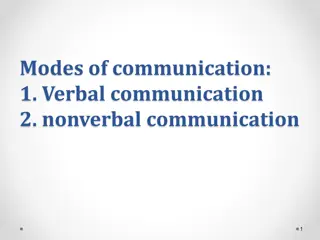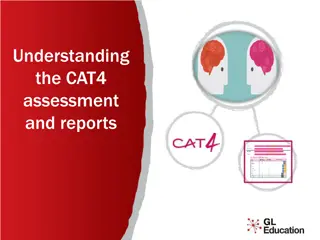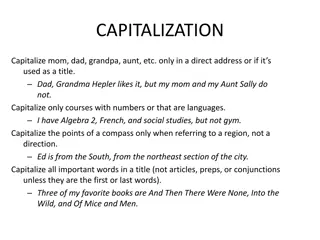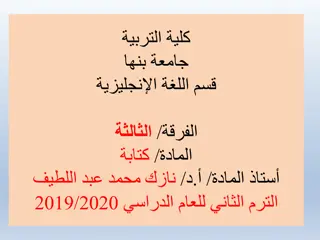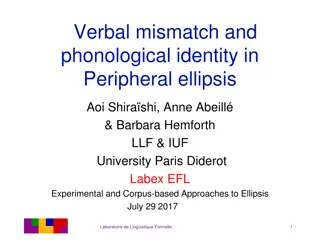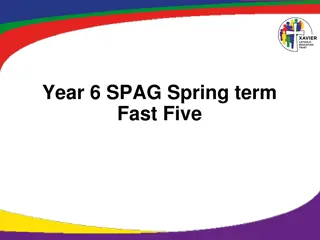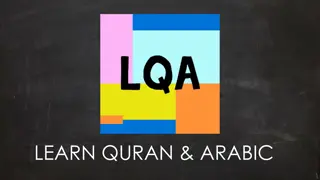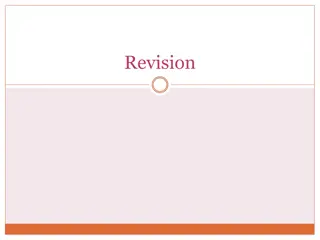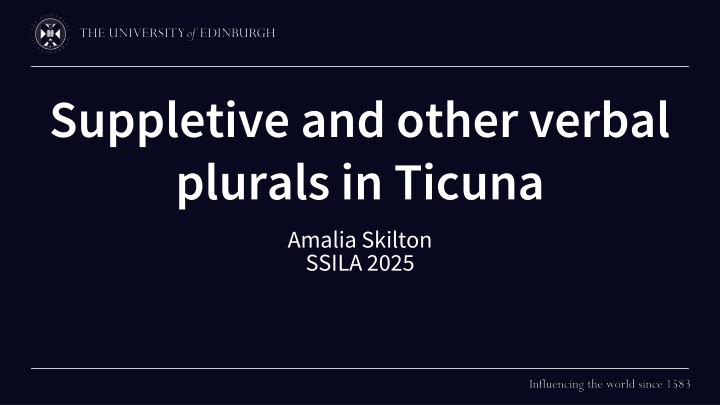
Verbal Plurals in Ticuna: Insights and Discoveries
Explore the complexities of verbal plurals in Ticuna, an Indigenous language spoken in Peru, Brazil, and Colombia. Learn about suppletive plurals, verb roots, concatenative plurals, and more. Discover fieldwork insights and research goals.
Download Presentation

Please find below an Image/Link to download the presentation.
The content on the website is provided AS IS for your information and personal use only. It may not be sold, licensed, or shared on other websites without obtaining consent from the author. If you encounter any issues during the download, it is possible that the publisher has removed the file from their server.
You are allowed to download the files provided on this website for personal or commercial use, subject to the condition that they are used lawfully. All files are the property of their respective owners.
The content on the website is provided AS IS for your information and personal use only. It may not be sold, licensed, or shared on other websites without obtaining consent from the author.
E N D
Presentation Transcript
Suppletive and other verbal plurals in Ticuna Amalia Skilton SSILA 2025
Motivations Many Indigenous languages of the Americas mark plural participant number in verbs via root suppletion: Uto-Aztecan, Dene, Tupian, Je Many languages also mark plural event numbervia suppletion: e.g., Tukanoan These can be hard to disentangle (Durie 1986; Fernald & Willie 2001; Harley 2014; Storto 2014; Farmer 2015; Toosarvandani 2016; Bardagil 2018 a.o.)
Goals of This Talk 1. Describe the conditioning of verb root suppletion vs. other forms of verbal number marking in Ticuna. 2. Demonstrate that this language combines suppletion for participant number with other strategies for marking eventnumber.
Isolate ~65,000 speakers Spoken by all ages in Peru, Brazil Endangered in Colombia Phonology well-described, other domains much less (Montes Rodriguez 1995; Soares 2000; Anderson & Anderson 2017; Santos Angarita 2013, 2022; Bertet 2021; Skilton 2023)
Fieldwork in Peru since 2015 In this area, Ticuna is the language of instruction in primary school Teachers have asked me to create reference materials for them on Number Gender/Noun class Tense
Roadmap 1. Suppletive plurals Verb roots Directionals 2. Concatenative plurals Suffixes Enclitics Proclitics/Conjugation class change 3. Discussion & conclusion
Fieldwork & Methods Sources of data for this talk include 1. Conversational transcripts 2. Narrative transcripts 3. Elicitation/judgments
The Verbal Word The minimum Ticuna verb includes: Subject proclitic Root (1) nu xu chadau n = 3=Acc I saw him/her/it. (elicited) t a =dau 1SgSbj=see
The Verbal Word Verb can contain up to 3 proclitics + suffixes + unlimited # enclitics (2) taguma ni i chanayoepeatu x ta gu ma ni never Foc =pe a t = =NI:wing =Sub I ve never trimmed its wings. (conversation) i = Dir= t a = 1SgSbj.Sc= na = 3Obj= cut.scissors -Dir:across o -e
Root Suppletion: Intransitives 5 IV roots + their morphologically derived stems display number suppletion Singular Root u a a u a u Plural Root i bu m i t o Gloss come, go, walk run flee fall stay
Root Suppletion: Intransitives IV root suppletion is based only on participant number (3), not event number (4). (3) taa ni yipu xu x ta ta a ni , Neg Foc Don t (do that), they (your marbles) will fall.Pl. (child-directed speech) i =p = ta fall.Pl=Clf:round=Sub Fut (4) mue pu cu na choru petu ca naru ngu / *naru yi mu e p k na t o r pe t ka many.times 1Sg.Poss marble My marble fell.Sg (*fell.Pl) many times. (elicited) na r = u / *na r = i 3Sbj=fall.Sg / *3Sbj=fall.Pl
Root Suppletion: Transitives 5 TV roots display number suppletion. 3/5 also display animacy suppletion. Singular Plural Animate Gloss ma dai (same) hit ta wo (same) discard, bury a na mu give nu mu put e na ga transport, bring, take
Root Suppletion: Transitives TV root suppletion is licensed by plural objects (5), including reciprocals (6). (5) n aa mu rapewagu i chanawogu a a Dem.Prox As for these planks, I m going to throw.Pl them away. (built space description) m ra pe wa =g plank=Pl i =t a =na =wo =g Dir=1SgSbj=3Obj=discard.Pl=Pl (6) otaaru dai naxu o ta =a r chicken=Poss Imitate how (two) chickens fight.Pl (each other). (child-directed speech) dai hit.Pl na = Imp=do
Root Suppletion: Transitives TV root suppletion is not licensed by plural agents (7) or events (8). (7) wu xi i woca tima gu / *tidaigu w i i wo ka one Det cow We killed.Sg (*killed.Pl) one cow. (elicited) ti =ma =g 1ExclSbj=hit.Sg=Pl / *ti =dai =g / *1ExclSbj=hit.Pl=Pl (8) Context: I tried over and over again to kill a pest, but it always escaped. u ca [chima xchau / *chadaichau ] t a ka t i =ma =t a / *t a =dai =t a rat 1SgSbj=hit.Sg=Prosp/ *1SgSbj=hit.Pl=Prosp I kept trying in vain to kill.Sg (*kill.Pl) the rat. (elicited) ta in.vain
Directional Suppletion Ticuna has many verbal directionals. About 11 are productive Attach to verbs of motion/caused motion Characterize shape of motion path (9) ngemaca ni naxchawa chanata nagu xu t a = na = ta 1SgSbj= 3Obj= discard.Sg That s why I threw it away into the rafters. (conversation) -na g -Dir:upward.Sg = =Sub
Directional Suppletion Directionals also undergo number suppletion This suppletion is controlled by the S of IV s, O of TV s For example, -ku tSi Dir:inward:SgO ~ -ku Dir:inward:PlO (10, 11) (10) tu xu ixu cuchi t = 3(I)=Acc Put it inside (a bag). (conversation) i = -ku t i Imp=put:InamSgO-Dir:inward:Sg (11) no ru pologu nanagu cu no r 3.Poss He would pour them (kernels of popcorn) into his shirt. (text) po lo gu shirt=Loc na =na =g -ku 3Sbj=3Obj=pour.grainy-Dir:inward:Pl
Directional Suppletion The suppletion is not licensed by a plural A (12) or plural event (13) (12) cuxu taxu cuchigu i no ru cumba ku = 2Sg=Ben We re going to install the cumba (part of a roof) for you. (conversation) ta = -ku t i =g 1Excl=put:InamSg-Dir:inward.Sg=Pl i Det no r 3Poss cumba cumba (13) nicacuchichigu ni = 3Sbj= lie.surface -Dir:inward.Sg He lies down under it (a chair) all the time (conversation) ka -ku t i =t i g =Distrib
Interim Summary Verb Root Suppletion u ~ i go Directional Suppletion -ku t i ~ -ku Dir:inward Example Plural S Plural O Plural A Plural Event
The Verbal Plural -e Combines only with certain intransitive verbs: mostly unaccusatives Licensed by plural S (14) but not plural event (15) (14) mama ru papa tapuracu e ma ma r mother and Mom and Dad Are Working (title of primary school reader) pa pa father ta =pu ra k -e 3HonSbj=work-Pl (15) Context: I worked on the same task in several places / at several different times. *chapuracu e *t a =pu ra k -e *1SG=work-PL (elicited)
The Nominal & Verbal Plural =g Differences from -e Pl: Can attach to nouns (incl. quantifiers) and adverbs Can occur on any verb, not only intransitives Forms single Prosodic Word with root Is a clitic =g is licensed by plural S, A or O,but not by plural events
The Nominal & Verbal Distributive =tig Attaches to verbs, nouns (incl. quantifiers), and adverbs Part of the distributive quantifier w i t i g every (< w i one ) Separate event for every member of the set, like English one by one
=g Can Quantify S & O (16) Lunesgu ta i nangugu lunes=gu Monday=Pl They will arrive on Monday (conversation) ta i =na = u =g Fut Dir=3Sbj=arrive=Pl Repeated from (5): n aa mu rapewagu i chanawogu a a Dem.Prox As for these planks, I m going to throw them away. (built space description) m ra pe wa =g i =t a =na =wo =g plank=Pl Dir=1SgSbj=3Obj=discard.Pl=Pl
=g Quantifies More Can also quantify As (17) but not events (18) (17) Bellavistawa choxu namugu a ru Bellavista=wa Bellavisa=All 1Sg=Acc 3Sbj=send=Pl=Info They sent meto Bellavista. (locality description) t o = na =mu =g =a r (18) Context: I sang several songs / using several microphones / in several places. *chawiyaegu *t a =wi ya e =g *1Sg=sing=Pl(elicited) Attempts to quantify events, as in (18), get corrected to adverbs or =t i g Distrib.
=tig Quantifies Most Subjects, objects, agents (19) and events (20) (19) tomae pu i duu xu gu chauchapenu xu niyauxchigu to ma e p i du =g t au =t a pe n three Det person=Pl Each of the three people washed my sheets. (elicited) ni = au =t i g 3Sbj=wash=Distrib 1Sg=sheet (20) Tigre nu xu naxu gachigu a ma Tigre n = (name) 3=ACC He keeps imitating Tigre s voice. (child-caregiver interaction) na = =ga =t i g =a ma 3Sbj=do=voice=Distrib=still
=tig Quantifies Degrees? Quantifying events is probably the most common use of =t i g in texts Another common reading: State (or end state of telic predicate) comes to hold more and more over time. (21) ma ma Perf Now Cushillococha is growing little by little. (locality description) ningu chigu a Cu xchitu ni = =t i g 3Sbj=populous=Distrib Det a K t i tu Cushillococha
Conjugation Classes & Conjugation Class Change Verbs are divided into 3 conjugation classes: /a/ vs /i/ vs /r/. Conjugation determines subject proclitic form: 3Sbj n =/ni =/na r = Many /a/-class verbs can be used with /i/ inflection (22) natu ru n u xma ru poraa cu ma nita na t r u ma but now But now it is quickly getting bigger. (locality description) r TOP po ra a k ma quickly ni =ta 3(i-class)=big(a-class)
Conjugation Class Change /a/ to /i/ conjugation class change: Can occur alone (22) or with =t i g (but not required w/ it: 20) Based on texts, seems to have the same possible readings as =t i g Arguments Events Degrees (22) However, people hate this structure in elicitation for anything but S
Summary Verb Root Suppletion Directional Suppletion =g Plural -e Plural =t i g Distrib Conj Class Change S O n/a (IV only) ? A n/a (IV only) ? Event ? ? ? Inchoative / Degree
Roots & Suffixes: Inflexible Verb root suppletion in Ticuna is exactlyas described for e.g. Hiaki Participant number Rigid absolutive pattern quantifying S & O, despite Nom/Acc alignment Directional suppletion and e Pl are also exclusively absolutive Verb stempattern is absolutive
Clitics: More Flexible Proclitics and enclitics can quantify: Any argument Events And even more: e.g., locations, parts of argument Verbal numberin general is not absolutive (or limited to participant number) once we move beyond the stem
Open Questions Why the contrast between judgments & texts for conjugation class change? Why the contrast between =g and =t i g ? Same morphophonological relationship with verb stem Can appear in either order Yet different possible domains of quantification
Thank you! Thanks also to Lilia Witancort Guerrero, Angel Bittancourt Serra, Deoclesio Guerrero Gomez, many conversational recording participants, & an anonymous participant NSF/NEH DEL/DLI
Nominal Number Not obligatory: nouns w/ no plural marking allow singular or plural readings Occurs with human, animate and inanimate nouns (1) Does not occur if the noun is quantified by a quantifier or numeral (1) Context: I saw two lakes/chickens/people. nataxa(gu )xu / ota(gu )xu / duu xu (gu )xu chadau na ta a (=g )= / o ta (=g )= lake(=Pl)=Acc / chicken(=Pl)=Acc I saw (the) lakes/chickens/people. (elicited) / du (=g )= / person(=Pl)=Acc t a =dau 1Sg=see See Skilton (2021) Liames for further details
Clitic vs. Suffix Tests Directionals and -e3 Pl: 1. Do not occur on nouns 2. Trigger allomorphy/other morphophonological changes in the root 3. Display semantic/syntactic restrictions on root 1-3 aren t true for enclitics and 2-3 aren t really true for proclitics
Suppletion + Causative (1) gua ma all I made all of the marbles fall (PlS). (LWG 2024.1.43) a Det pe ta ka t = marble(I) 3(I)=Acc t a r = i -e e 1SgSbj=fall.Pl-Caus (2) t au =ne =g = w i i 1Sg=son=Pl=Acc I had my sons slaughter (*PlO) a cow. (DGG 2017.2.195) wo ka t i =ma -e e / *t a =dai -e e cow 1SgSbj=kill.Sg-Caus / *1SgSbj-kill.Pl-Caus one Det
Suppletion + Incorporation (1) Context: Carlos slaughtered several of my farm animals. Ka ru r t o = ni =ma = na Carlos Top 1Sg=Acc Carlos livestock-slaughtered (Pl) me. (elicited) / na =dai = na / 3Sbj=kill.Pl=NI:pet 3Sbj=kill.Sg=NI:pet (2) Context: My relative and I own 1 cow together. Carlos slaughtered it. Ka ru r to = ni =ma =a r Carlos Top 1Excl=Acc 3Sbj=kill.Sg=NI Carlos cow-slaughtered (Sg. *Pl) us. (elicited) / na =dai =a r / 3Sbj=kill.Pl=NI wo ka =a NI:cow=NI
Social Impacts Explaining this system concisely will be challenging Many common verbs have even more irregularity/suppletion than shown here Extensive L1 transfer affecting number agreement in speakers Spanish Perhaps the most concise description: Number is expressed on many verbs & not very many nouns






